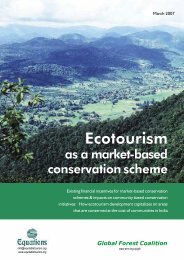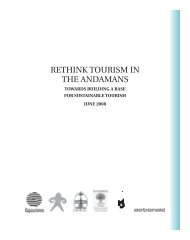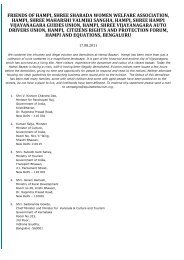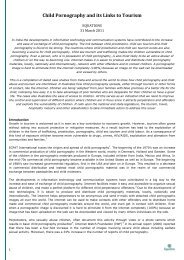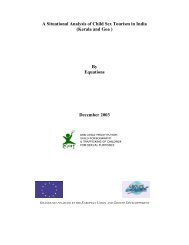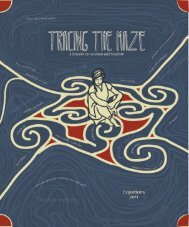Nilgiris Biosphere Reserve - Equitable Tourism Options
Nilgiris Biosphere Reserve - Equitable Tourism Options
Nilgiris Biosphere Reserve - Equitable Tourism Options
You also want an ePaper? Increase the reach of your titles
YUMPU automatically turns print PDFs into web optimized ePapers that Google loves.
commodification of natural resources such as land, water and trees and<br />
minor forest produce are the areas of contradiction between the local<br />
people and industry. Disrupting the course of migratory routes in the<br />
elephant corridor in Masinagudi, Bokkapuram, Anaikkatty, and<br />
Thuvaipathy areas is also posing a danger to the existence of elephants<br />
and creating man-animal conflicts.<br />
There are ongoing discussions with the unsettled issue of displacement<br />
and negation of traditional and historic rights to the forest community when<br />
colonial laws were introduced in the country. The fast depletion of forests<br />
and thereby the flora and fauna has put people concerned with<br />
conservation, the government and the development ofthese forest areas at<br />
loggerheads. <strong>Tourism</strong> is yet another entry into these already heated<br />
turmoil.<br />
The indigenous people and their rights issue today are more assertive and<br />
political. The forest laws have not been able to match the demands of the<br />
community. Therefore it is quite logical when the community raise the<br />
legitimacy of tourism in the forest region, whereby another new actor<br />
comes to these regions, while issues that the community raised still remain<br />
unresolved. Also the fact that the tourism industry is able to bypass the laws<br />
if they wish to had angered the community. This was evident in the Taj -<br />
Nagarahole National Park in Karnataka. While the community was up in<br />
arms against the displacement, the forest department allowed a three star<br />
hotel inside the national park in vwlation to the Wild life (Protection) Act,<br />
1972 is a pointer to the ongoing debate and to see on whose side the<br />
balance tilts.<br />
The extent to which forests and ecologically sensitive regions need to be<br />
open for tourism with the adding pressures is yet another area of concern.<br />
The very fact that protected areas does not allow human intervention is<br />
challenged by tourism. Carving out tourism zones out of protected areas is<br />
the new trend. But even then would this be able to withstand the tourist<br />
pressure is under debate. The creation of tourism zones within protected<br />
areas gives legitimacy to tourism inside. Currently, the Forest laws regulate<br />
this activity to some extent. As tourism gains more momentum, and 100%<br />
FDI accorded to tourism by the Central Government, the chances of these<br />
areas getting privatised become more probable (like heritage sites now<br />
being privatised, e.g., Taj Mahal.)<br />
<br />
<br />
£Quotkm<br />
Nilagiris: Fading Glory 14



